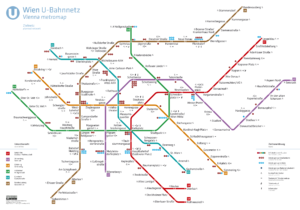The responsible Viennese districts are in regular contact with Wiener Linien and the Municipal Department 18 (Urban Development and Urban Planning). In these discussions, an attempt is made, among other things, to record important points from the point of view of the residents and owners. Afterwards, MA 18 completes the general planning and hands over the project to Wiener Linien during an “audit” – Wiener Linien are responsible for the project from this point on.
The district administration can again raise concerns during this “audit” and request that these be included in the minutes.
The following points in particular may be of importance to the district administration with regard to further planning:
- Tree cutting;
- Traffic solutions during construction;
- Communication with the business community,
- Coordination with the district administration regarding the location of ventilation shafts;
- Information of the owners;
- Timely involvement of the district administration in the further planning of the surface design; and
- Ongoing and timely information of residents about upcoming construction phases.
Monitoring / contact person during the construction period?
What do I have to do / who can I turn to if I have concerns?
In principle, there is an ombudsman or ombudswoman for each construction phase who can be contacted on site in the construction office and by telephone for the concerns of the residents and owners. The ombudsmen are technicians of Wiener Linien and are involved in the work on site. This makes them an important and proven interface between the construction project and the residents: They have an open ear, provide first-hand information and try to find solutions together.
During the entire construction period, each construction section has a technical manager from Wiener Linien. ln his responsibility, of course, is also safety. Should it become apparent in the course of the construction work that further safety measures are necessary on the houses above, these will of course be taken immediately by Wiener Linien. If residents become concerned during construction or discover cracks or similar, they can immediately contact the responsible ombudsmen. Wiener Linien will then react immediately and investigate the matter.
Why do structural inspections take place? What is being checked?
Wiener Linien must prove before the start of construction that the foundations of all houses in the area of the route (approx. 30 meters to the left and right of the future tunnels, depending on the depth) comply with current norms and standards.
For new buildings, information on the foundation is noted in the construction file. The situation is different for buildings constructed before the Second World War or in the immediate post-war period. Here, there is usually no documentation at all or only insufficient documentation. In addition, the applicable standards have recently been amended and adapted to the current state of construction technology.
In order to ensure a safe and smooth construction process, the type, depth and condition of the foundations must therefore be determined before construction of the subway begins. The structural analysis of the building is recalculated on the basis of this information. If it does not meet current standards, the foundation will be reworked at the expense of Wiener Linien. This is not only an important investment in safety, but also goes hand in hand with a sustainable improvement in the substance of the building in question.
What do foundation improvements look like?
The foundations must comply with current standards and norms prior to tunneling. If this is not the case, depending on the condition and type of foundation, a foundation slab is constructed, for example, or the existing foundation is deepened or widened. These important preliminary works are part of the first construction measures.
The work takes place from the basement. Since the cellars have to be empty for this purpose, alternative quarters (containers, empty rooms) are provided in the immediate vicinity during the foundation improvement work. Companies commissioned by Wiener Linien will relocate the stored items properly in the presence of the owners and return them to the basement after completion of the work. The owners will be informed in due time.
How do I get an expert opinion? Can I have it?
After completion of the entire house appraisal, a copy can be requested through the responsible ombudsmen. House appraisals that have not yet been completed cannot be passed on. However, it is possible to inspect the current status (e.g. structural analysis) on site in the building office.
House appraisals consist of the result of the foundation survey, the protocol of the inspection of the general house areas and the protocol of the inspection of each apartment and room.
When and how does the walk-through of the housing units take place?
The inspection will take place as close as possible to the actual tunneling. Depending on the construction phase, these inspections will therefore also take place differently.
The appointment will be made by the expert commissioned by Wr. Linien in consultation with the users of the apartment. If owners of rented apartments wish to be present during the inspection, they should inform their tenants.
Of course, you are also free to commission your own surveyor. However, this is to be paid by the client and not by Wiener Linien.
Where can I request the relevant documentation?
The protocol of the house inspection is part of the house appraisal and can be requested via the respective ombudsman after completion. Until completion, the file can be inspected at the relevant building office.
Sound measurement during metro operation
An initial sound measurement will be carried out six months after the opening of the new lines. This is in accordance with the provisions of the railroad law procedure and would be the same for an environmental impact assessment (EIA).
If requested, Wiener Linien will be happy to carry out a second measurement after twelve months on a voluntary basis. Residents and owners can contact Wiener Linien at any time by e-mail or telephone.
Easement and compensation for it
All owners are treated equally and are offered a contractual fee for the granting of the easement(s). A court-certified and internationally accredited expert is commissioned with the valuation. An experienced expert in the field of valuation of rights for infrastructure assets, who determines the respective property disadvantage according to recognized, standardized procedures.
This fee is intended to compensate for the property disadvantage directly caused by the easement. Relevant factors include, in particular, the area, depth and duration (e.g. temporary or permanent) of the use.
Due to the outstanding complexity of the project, there may be a delay in the general planning. After that, the official transfer of the project to Wiener Linien will take place. As soon as this is done, the dispatch of the required contracts can be started.
Business operators
The joint subway aid program of the City of Vienna and the Vienna Chamber of Commerce provides financial grants for companies that are affected by a sharp drop in sales due to the subway construction. According to reports, the funding guidelines can be revised.
As soon as the project has been approved for implementation by the City of Vienna, Wiener Linien will organize a meeting for entrepreneurs at which the relevant contact persons (Wr. Linien, Wirtschaftskammer, Wirtschaftsagentur, etc.) will be present.
Until then, business people can contact the Vienna Business Agency. The employees are involved in the project and are also in regular exchange with the Wiener Linien as well as the responsible departments of the city.
Rough schedule
The handover of the planning project to Wiener Linien is an important milestone on the way to further subway expansion. Wiener Linien will subsequently submit the project for approval and are confident that the tenders for the shell construction of the stations can start within a few months. After that, construction can begin.
Initial work will include relocating fixtures and improving foundations where necessary.
As soon as the above-mentioned tenders have been completed, Wiener Linien will provide further information on the construction schedule.



